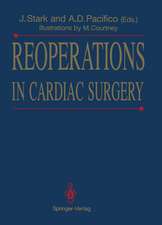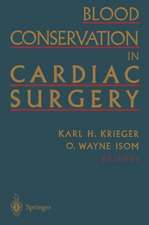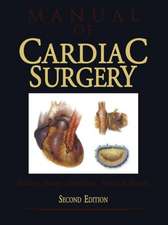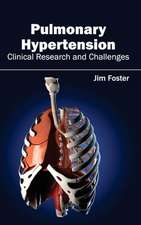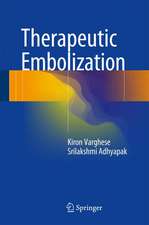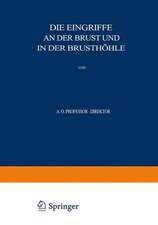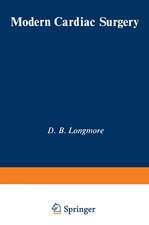Ventricular Geometry in Post-Myocardial Infarction Aneurysms: Implications for Surgical Ventricular Restoration
Autor Srilakshmi Adhyapak, Srilakshmi M. Adhyapaken Limba Engleză Paperback – 30 apr 2017
| Toate formatele și edițiile | Preț | Express |
|---|---|---|
| Paperback (1) | 884.68 lei 38-44 zile | |
| SPRINGER LONDON – 30 apr 2017 | 884.68 lei 38-44 zile | |
| Hardback (1) | 718.10 lei 43-57 zile | |
| SPRINGER LONDON – 7 iun 2012 | 718.10 lei 43-57 zile |
Preț: 884.68 lei
Preț vechi: 931.23 lei
-5% Nou
Puncte Express: 1327
Preț estimativ în valută:
169.28€ • 177.22$ • 140.07£
169.28€ • 177.22$ • 140.07£
Carte tipărită la comandă
Livrare economică 02-08 aprilie
Preluare comenzi: 021 569.72.76
Specificații
ISBN-13: 9781447169741
ISBN-10: 1447169743
Pagini: 152
Ilustrații: XVI, 152 p. 77 illus., 37 illus. in color.
Dimensiuni: 178 x 254 mm
Ediția:Softcover reprint of the original 1st ed. 2012
Editura: SPRINGER LONDON
Colecția Springer
Locul publicării:London, United Kingdom
ISBN-10: 1447169743
Pagini: 152
Ilustrații: XVI, 152 p. 77 illus., 37 illus. in color.
Dimensiuni: 178 x 254 mm
Ediția:Softcover reprint of the original 1st ed. 2012
Editura: SPRINGER LONDON
Colecția Springer
Locul publicării:London, United Kingdom
Cuprins
1.Foreword.- 2.Preface.-3.Architecture of the normal heart.- 4.The normal mechanisms of cardiac contraction and relaxation.- 5.Alterations in cardiac geometry with heart failure.- 6.Perturbations in contraction and relaxation with heart failure.- 7.Hemodynamics in ischemic cardiomyopathy.- 8.History of surgical ventricular restoration.- 9.Evolution of surgical ventricular restoration to endoventricular linear patch plasty(EVLPP).- 10.Validation of near physiological restoration of left ventricular geometry by EVLPP.- 11.Physiological considerations in the relationships of left ventricular volumes.- 12.Evidence of an extension of Frank Starling mechanism in the failing heart.- 13.Concomitant procedures with surgical ventricular restoration: Indications and techniques.
Notă biografică
V. Rao Parachuri FRCS (CTh) has trained at Hammersmith and Harefield Hospitals, UK and worked as fellow at St. Vincent Hospital, Worcester, Massachusetts, USA. His field of interest is in the surgical management of heart failure with special interest in surgical ventricular restoration. He has developed the linear endoventricular patch plasty procedure which is a modification of the endoventricular patch plasty techniques described by others. He has performed over 800 surgical ventricular restoration procedures. His other interests include mitral and aortic valve repairs and surgical pulmonary vein isolation for atrial fibrillation. He is Senior Consultant Cardiac Surgeon at Narayana Hrudayalaya Institute of Medical Sciences, Bangalore, India.
Srilakshmi M. Adhyapak DNB is a fellow in Cardiology from Narayana Hrudayalaya Institute of Medical Sciences, and is presently Assistant Professor of Cardiology at St. John’s Medical College Hospital, Bangalore, India. Her interests are in the pathophysiology of heart failure.
Srilakshmi M. Adhyapak DNB is a fellow in Cardiology from Narayana Hrudayalaya Institute of Medical Sciences, and is presently Assistant Professor of Cardiology at St. John’s Medical College Hospital, Bangalore, India. Her interests are in the pathophysiology of heart failure.
Textul de pe ultima copertă
Following a transmural myocardial infarctions (MI), the resultant dilated, aneurismal ventricle can make patient management difficult in those ineligible for cardiac transplantation. This mechanical complication leads to refractory heart failure and continues to be a persisting problem for clinical management in both the developed and developing countries of the world. It continues to exist despite improvements in door to needle time for primary coronary interventions.
There has been increased interest in potential surgical techniques involved in the palliation of ventricular pathology post-MI. The process of cardiac remodeling has been studied extensively, and recent surgical techniques for ventricular restoration have proven late adverse remodeling. Surgical techniques for ventricular restoration of these adversely remodeled ventricles aimed at restoring a near normal ventricular geometry consequently have a continuing role in the management of this difficult subset of patients.
Ventricular Geometry in Post-Myocardial Infarction Aneurysms: Implications for Surgical Ventricular Restoration provides cardiac surgeons and cardiologists a definitive perspective of optimal surgical ventricular restoration in patients with advanced heart failure due to large ventricular aneurysms following transmural myocardial infarctions. The authors review normal and abnormal cardiac anatomy following post myocardial infarction and physiology, with focus on the evolution of surgical techniques aimed at establishing an ellipsoid ventricular shape, resulting in near-normal physiological hemodynamics evident at long term.
There has been increased interest in potential surgical techniques involved in the palliation of ventricular pathology post-MI. The process of cardiac remodeling has been studied extensively, and recent surgical techniques for ventricular restoration have proven late adverse remodeling. Surgical techniques for ventricular restoration of these adversely remodeled ventricles aimed at restoring a near normal ventricular geometry consequently have a continuing role in the management of this difficult subset of patients.
Ventricular Geometry in Post-Myocardial Infarction Aneurysms: Implications for Surgical Ventricular Restoration provides cardiac surgeons and cardiologists a definitive perspective of optimal surgical ventricular restoration in patients with advanced heart failure due to large ventricular aneurysms following transmural myocardial infarctions. The authors review normal and abnormal cardiac anatomy following post myocardial infarction and physiology, with focus on the evolution of surgical techniques aimed at establishing an ellipsoid ventricular shape, resulting in near-normal physiological hemodynamics evident at long term.
Caracteristici
Clinical validation of a mathematical hypothesis, by the technique of EVLPP Clinical validation of a mathematical hypothesis, by the technique of EVLPP Clinical validation of a mathematical hypothesis for the existence of an extension of the Frank Starling mechanism in the failing heart Extensive video files of the surgical technique
Descriere
Descriere de la o altă ediție sau format:
The topic of heart failure although extensively researched and reported, has several gray areas. This is especially seen in determining strategies for combating advanced heart failure. The global burden of ischemic heart disease is increasing at an alarming rate to almost pandemic proportions. Even in the presence of state-of the art technology for prompt and successful coronary reperfusion, the population progressing to ischemic cardiomyopathy is substantial. The treatment strategies for ischemic cardiomyopathy do not always ensure optimal clinical results, the reasons for which are varied. The proper patient selection is vital as is the tailoring of suitable therapy. The approach is thus multi-pronged, of which surgical ventricular restoration (SVR) has a definite role. Despite various randomized studies like the STICH-hypothesis 2, where there was a huge selection bias, with patients subjected to an erroneous technique of SVR, with inadequate ventricular remodelling assessment. The present need is to understand the unique anatomy of the left ventricle, its function and perturbations with the onset of heart failure, in order to plan therapeutic strategies to restore near normal anatomy and function. A study of the hemodynamics in ischemic cardiomyopathy is essential, as it differs in certain aspects from other causes of heart failure like idiopathic dilated cardiomyopathy and valvular heart diseases. Since information on these aspects are scattered in various scholarly articles, a concise source in the form of a book would be appropriate and useful for both cardiologists and cardiac surgeons. This project represents a concise review of normal and abnormal cardiac anatomy and physiology, the evolution of SVR to EVLPP with validation of near normal ventricular restoration, plus act as a reference guide for cardiac surgeons with interest in SVR.
The topic of heart failure although extensively researched and reported, has several gray areas. This is especially seen in determining strategies for combating advanced heart failure. The global burden of ischemic heart disease is increasing at an alarming rate to almost pandemic proportions. Even in the presence of state-of the art technology for prompt and successful coronary reperfusion, the population progressing to ischemic cardiomyopathy is substantial. The treatment strategies for ischemic cardiomyopathy do not always ensure optimal clinical results, the reasons for which are varied. The proper patient selection is vital as is the tailoring of suitable therapy. The approach is thus multi-pronged, of which surgical ventricular restoration (SVR) has a definite role. Despite various randomized studies like the STICH-hypothesis 2, where there was a huge selection bias, with patients subjected to an erroneous technique of SVR, with inadequate ventricular remodelling assessment. The present need is to understand the unique anatomy of the left ventricle, its function and perturbations with the onset of heart failure, in order to plan therapeutic strategies to restore near normal anatomy and function. A study of the hemodynamics in ischemic cardiomyopathy is essential, as it differs in certain aspects from other causes of heart failure like idiopathic dilated cardiomyopathy and valvular heart diseases. Since information on these aspects are scattered in various scholarly articles, a concise source in the form of a book would be appropriate and useful for both cardiologists and cardiac surgeons. This project represents a concise review of normal and abnormal cardiac anatomy and physiology, the evolution of SVR to EVLPP with validation of near normal ventricular restoration, plus act as a reference guide for cardiac surgeons with interest in SVR.



